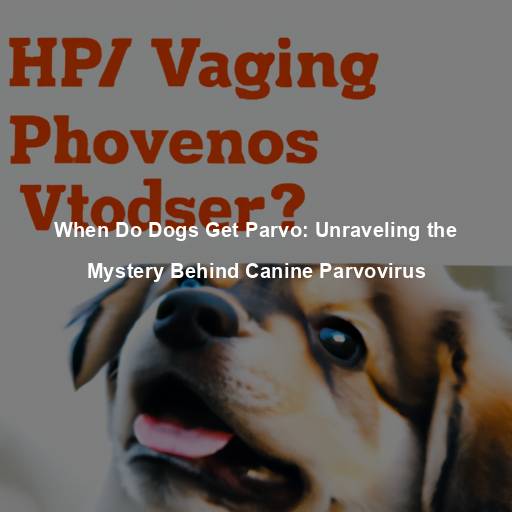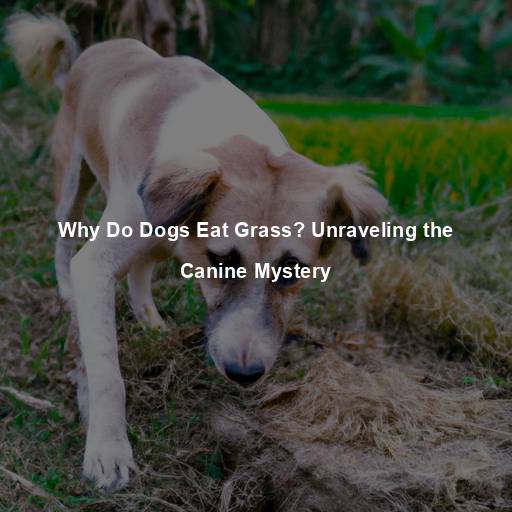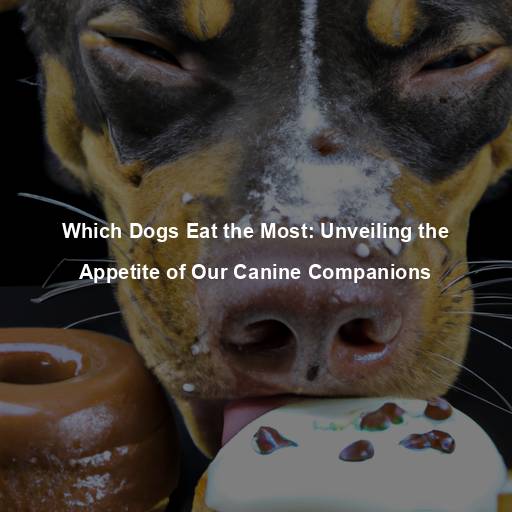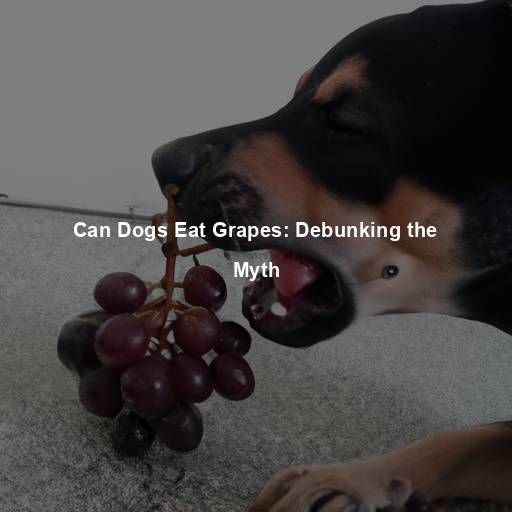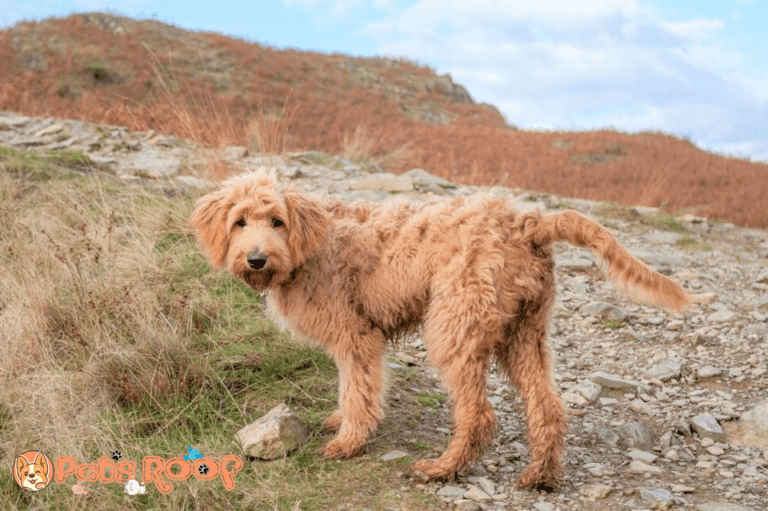When Do Dogs Get Parvo: Unraveling the Mystery Behind Canine Parvovirus
Last Updated on July 30, 2023 by Evan
Contents [hide]
- 1 The Persistence of Canine Parvovirus
- 2 Early Signs and Symptoms
- 3 Heightened Susceptibility: Puppies and Unvaccinated Dogs
- 4 Identifying Parvo: Diagnostic Measures
- 5 Treatment: Battling Parvo Head-On
- 6 Prevention: The Power of Vaccination
- 7 Parvo Prevention: Building a Strong Defense Against the Virus
- 8 The Importance of Spreading Awareness: Educating Others
- 9 FAQs – When do dogs get parvo?
- 9.1 Q: What is parvo and how do dogs contract it?
- 9.2 Q: At what age are dogs most susceptible to parvo?
- 9.3 Q: Can vaccinated dogs still get parvo?
- 9.4 Q: What are the common symptoms of parvo in dogs?
- 9.5 Q: How long does it take for dogs to show symptoms after exposure to parvo?
- 9.6 Q: Can humans contract parvo from dogs?
- 9.7 Q: How can I prevent my dog from getting parvo?
- 9.8 Q: Can dogs recover from parvo?
- 9.9 Q: Is parvo contagious to other animals besides dogs?
The Persistence of Canine Parvovirus
Canine parvovirus, commonly known as parvo, is a highly contagious and potentially fatal disease that affects dogs. It primarily targets the gastrointestinal system, leading to severe vomiting, diarrhea, and dehydration. Parvo is caused by the canine parvovirus type 2 (CPV-2), a resilient and persistent virus that can survive in the environment for extended periods.
Understanding the Transmission
Parvo is transmitted through direct contact with infected dogs or their bodily fluids, such as feces or vomit. It can also spread indirectly through contaminated objects, such as food bowls, bedding, or any surface that has come into contact with the virus. Puppies and unvaccinated dogs are particularly vulnerable to parvo.
The Incubation Period
After exposure to the virus, an infected dog may not show immediate symptoms. The incubation period for parvo typically ranges from 3 to 7 days. During this time, the virus silently replicates within the dog’s body, primarily targeting rapidly dividing cells in the intestines and bone marrow.
Early Signs and Symptoms
As the virus progresses, the infected dog begins to display various symptoms. These early signs often include:
Experiencing a sudden loss of appetite can be quite perplexing, as it might signify an underlying health concern that needs to be addressed. This phenomenon, which could potentially be linked to serious conditions like parvo, can leave both individuals and their loved ones feeling uncertain and uneasy. It’s essential to seek medical advice to understand the cause behind this unexpected change in food consumption and to ensure one’s well-being is safeguarded.
When it comes to dogs infected with parvo, one of the significant symptoms to look out for is lethargy. These furry friends might display an abnormal level of fatigue and lack the usual energy you’d expect to see. Their overall enthusiasm and liveliness might be replaced with a sense of sluggishness and weariness.
The rise in body temperature, often accompanied by uncontrollable shivers and trembling, is a prevalent indication of parvo. It’s no wonder that this perplexing phenomenon has left many scratching their heads in confusion, trying to understand the burst of heat coursing through their body. But fear not, for our experts have unraveled the enigmatic connection between parvo and fever, bringing forth a glimmer of clarity amidst the puzzling complexity of this ailment.
Vomiting, be it occasional or unrelenting, may manifest as a conspicuous indication of parvo, leaving both pet owners and medical professionals puzzled. This erratic discharge of gastric contents can conveniently serve as an initial red flag, urging individuals to seek immediate medical attention. The intermittent nature of this symptom only adds to the perplexity of the situation, further emphasizing the importance of early detection and prompt intervention against this virulent disease.
When our furry friends fall ill, it can be quite a bewildering experience for both them and their owners. One of the common symptoms to look out for is diarrhea, which can vary from being watery to even containing blood. This distressing condition can quickly lead to dehydration, making it crucial to seek prompt veterinary care to alleviate their discomfort and restore their health.
Heightened Susceptibility: Puppies and Unvaccinated Dogs
Puppies: The Most Vulnerable
When it comes to parvo, puppies are the most vulnerable bunch, especially those who are still sprightly under six months. Their sweet little immune systems are not quite up to par, which puts them at a higher risk of falling victim to this nasty virus. To ensure their safety and well-being, it is of utmost importance to get these furry friends vaccinated on time, preventing any grave consequences that may arise.
Unvaccinated Dogs: A Constant Risk
It’s a fact well-known that parvo poses a formidable threat to our beloved canines, particularly those who haven’t received any vaccinations. Whether we’re talking about the tender, wide-eyed puppies or our faithful adult companions who somehow missed their shots, the absence of immunization renders them utterly vulnerable against this viral adversary. Without a doubt, administering regular vaccines takes center stage in fortifying their immunity and safeguarding their overall welfare.
Identifying Parvo: Diagnostic Measures
Veterinary Examination
When it comes to our furry friends, especially the four-legged ones, it’s essential to be vigilant and take action if we suspect something might be wrong. One concerning possibility is parvo, a highly contagious disease that can affect dogs. If you notice any signs or symptoms that raise suspicion, such as lethargy, vomiting, or diarrhea, it’s crucial to reach out to a veterinarian without delay. By providing a detailed account of your dog’s medical history and observed symptoms, as well as allowing for a thorough physical examination, you’ll empower the vet to make an informed initial assessment and recommend the appropriate course of action.
Laboratory Tests
To confirm a diagnosis of parvo, veterinarians often perform specific laboratory tests. These tests may include:
- Fecal ELISA Test: This test detects the presence of parvovirus antigens in the dog’s feces, providing a quick and accurate diagnosis.
- Complete Blood Count (CBC): A CBC helps evaluate the dog’s overall health and assess the severity of the infection by measuring various blood components.
- PCR Test: Polymerase Chain Reaction (PCR) testing is a highly sensitive method that detects the DNA of the parvovirus, allowing for early detection and accurate diagnosis.
Treatment: Battling Parvo Head-On
Hospitalization and Supportive Care
When it comes to dogs grappling with parvo, things can get quite intense. These furry patients demand some serious veterinary TLC, with a touch of vigilance, fluid therapy, and a side of meds to ease their symptoms. Ensuring they’re up to snuff through hospitalization, we tackle the dehydration front with a crucial IV fluid infusion, while combating tummy troubles with anti-nausea and anti-diarrheal prescription wizardry.
Isolation and Hygiene
Canine parvovirus is highly contagious and can spread rapidly, making isolation protocols crucial. Infected dogs should be kept away from unvaccinated or vulnerable animals to prevent further transmission. Additionally, strict hygiene measures, such as frequent disinfection of the environment and thorough handwashing, are essential to limit the spread of the virus.
Nutritional Support
Ensuring the right nourishment is a crucial factor in the recuperation process for dogs battling parvo, but the journey can be quite perplexing. When mealtimes become a struggle for our furry friends, some may even require the help of a feeding tube to maintain adequate sustenance. Thankfully, under the compassionate guidance of a veterinarian, pet owners can navigate the labyrinth of dietary choices and discover the perfect blend of nutrients and supplements to aid their canine companions on the road to recovery.
Prevention: The Power of Vaccination
Vaccination Schedule
Protecting our furry companions from the destructive force of parvo is of utmost importance, with vaccination being the key to their defense. From the tender age of 6 to 8 weeks, our precious puppies embark on a series of immunizations that mold their resilient shield. These vital shots, administered every 3 to 4 weeks, continue until our little ones reach the milestone of 16 weeks. However, the journey to everlasting immunity doesn’t stop there, as booster shots are required at regular intervals to uphold this invisible fortress.
Environmental Precautions
In the quest to safeguard furry friends from the dreaded parvo, upholding a pristine and germ-free sanctuary for dogs reigns supreme. Remember: a thorough cleansing ritual for their bowls, toys, cozy bedding, and living quarters acts as the ultimate viral exterminator. Steer clear of exposing unvaccinated canines to spaces frequented by potentially infected furry companions. Let’s keep our beloved pooches protected!
Responsible Pet Ownership
In the ever-evolving world of pet ownership, there exists an undeniable responsibility that rests upon our shoulders – that of curbing the notorious spread of parvo. It is amidst this perplexing web of our commitment to our beloved four-legged friends that we find significance in maintaining a steadfast devotion to their holistic welfare. Only through the diligent pursuit of regular veterinary care, from the prism of vaccinations to the multifaceted realm of comprehensive well-being, can we dare to unravel the enigmatic nature of this canine community we so deeply cherish.
The Road to Recovery
Recovering from a parvovirus infection can be a challenging and lengthy process for dogs. While some pups may bounce back relatively quickly, others may experience long-term effects that require ongoing care and attention.
Gastrointestinal Complications
Parvo, a notorious virus, can unleash a chain of perplexing gastrointestinal complications, shaking the very core of a dog’s health. Its cunning target, the cells lining the intestines, unleashes havoc and inflammation, leaving behind a lingering trail of chronic digestive woes. Malabsorption, chronic diarrhea, and weight loss become the unwelcome companions of our furry friends, pushing them into the realm of special diets and medications to navigate these turbulent gastrointestinal waters.
Weakened Immune System
When it comes to our furry friends, few things are more concerning than a weakened immune system. Parvo, a notorious culprit, has a knack for wreaking havoc on dogs, rendering them vulnerable to a host of other infections and diseases. Surviving this malicious virus doesn’t necessarily mean smooth sailing either, as it can leave our beloved pooches prone to recurrent illnesses and a constant battle against everyday pathogens. The key to keeping our furry companions healthy and resilient lies in regular visits to the vet and ensuring they receive the necessary vaccinations to fortify their precious immune systems.
Cardiac Complications
Parvovirus, an infrequent yet formidable challenge, has the ability to launch a surreptitious attack on the canine heart muscle. This perplexing condition, aptly termed myocarditis, manifests as a labyrinth of cardiac quandaries: from erratic beats that dance out of sync to the heart’s weary cry for reprieve. Those afflicted by this enigma may find solace in a lifelong regimen of careful vigilance and pharmaceutical intervention, as they navigate the turbulent waters of cardiac well-being.
Emotional Trauma
Beyond the physical effects, parvo can also leave a lasting emotional impact on both dogs and their owners. The intense symptoms, hospitalization, and sometimes even loss of a beloved pet can be traumatic for everyone involved. It is crucial to provide emotional support to both the dog and the owner during the recovery process, whether through counseling, support groups, or simply offering a sympathetic ear.
Parvo Prevention: Building a Strong Defense Against the Virus
Vaccination: The First Line of Defense
The most effective way to prevent parvovirus infection is through vaccination. Puppies should receive a series of vaccinations starting at around 6 to 8 weeks of age, with regular boosters until they complete the vaccination schedule. Adult dogs should also receive regular vaccinations to maintain immunity. Consult with your veterinarian to ensure your dog’s vaccinations are up to date.
Avoiding High-Risk Environments
Parvo is highly contagious and can survive in the environment for extended periods. To reduce the risk of exposure, it is important to avoid high-risk areas, such as dog parks, kennels, or areas with a known outbreak. Be cautious when introducing your dog to new environments and other dogs, especially if their vaccination status is unknown.
Proper Hygiene Practices
Keeping up with proper hygiene practices is absolutely crucial when it comes to halting the transmission of the notorious parvovirus. To sprinkle some clarity into the matter, we’ve gathered a handful of vital steps that you should most definitely incorporate into your routine. So, without further ado, let’s unravel the mystery and embrace a cleaner, safer environment!
Keeping your furry friend’s environment clean and germ-free is essential to their well-being. Remember to regularly disinfect their living area, toys, bedding, and food bowls. Consult with your trusted veterinarian for the most effective bleach solution to eradicate any potential viruses lurking around. Prioritizing cleanliness is a vital step in maintaining your dog’s health and happiness.
– Handwashing: After handling dogs or coming into contact with potentially contaminated surfaces, make sure to wash your hands thoroughly with soap and water.
When dealing with a dog afflicted with the highly contagious parvo virus, it is crucial to prioritize isolation as a preventive measure against spreading the sickness. By confining the infected dog to separate quarters, preferably devoid of any interaction with other animals, the transmission of this dangerous disease can be effectively curtailed. Limiting their exposure to communal spaces and minimizing contact with unvaccinated or susceptible dogs further ensures the well-being of all furry companions involved.
The Importance of Spreading Awareness: Educating Others
Sharing Knowledge
As a renowned magazine, we are dedicated to shedding light on the perplexing and bursty issue of canine parvovirus. By collectively raising awareness, we can combat the devastating impact this disease has on our beloved furry friends. Let’s engage in thought-provoking conversations with our loved ones and fellow dog enthusiasts, emphasizing the paramount significance of vaccinations, impeccable hygiene habits, and prompt detection. Spark a ripple effect by encouraging others to seek professional veterinary care while also providing valuable resources like informative articles and educational materials, fostering a knowledgeable and protective community.
Supporting Local Shelters and Rescue Organizations
In the realm of animal welfare, shelters and rescue organizations face a recurring challenge, the ever-present specter of parvovirus. This formidable adversary looms particularly large in regions where resources are scarce and options are few. However, there is a glimmer of hope amidst the haze of uncertainty. By extending a helping hand, be it through monetary contributions, selfless acts of volunteerism, or even the noble act of providing temporary shelter as a foster parent, you hold the power to be a ray of light for these afflicted canines.
Social Media Outreach
Tap into the dynamic realm of social media to ignite a fervent crusade against the pernicious parvo. Unleash a cornucopia of enlightening posts, captivating infographics, and poignant anecdotes to enrapture your digital tribe, inspiring a tsunami of comprehension and empathy. Ignite a cascading chain reaction, beseeching all to amplify the clarion call, thus elevating the impact and scope of this crucial missive.
FAQs – When do dogs get parvo?
Q: What is parvo and how do dogs contract it?
B: Brace yourself for a perplexing viral storm, pet lovers! The menace known as parvo, a cunning abbreviation for the fierce canine parvovirus, has reared its ugly head once again, causing a frenzy among our four-legged friends. This highly contagious disease targets puppies with particular cruelty, leaving their unsuspecting owners in a state of bewilderment. Threading its way through the very blades of grass and lingering on the most innocent of surfaces, parvo poses a menacing threat, capable of transmitting its treachery through the mere touch of a hand, the fabric of clothing, or the soles of shoes. Let’s delve into this mysterious pet nightmare and explore how to navigate these viral quicksand’s with safety and caution.
Q: At what age are dogs most susceptible to parvo?
A: Dogs, particularly puppies, are most susceptible to parvo between the ages of six weeks and six months. This is because their immune systems are still developing during this period, making them more vulnerable to the virus. However, parvo can affect dogs of any age if they have not been properly vaccinated.
Q: Can vaccinated dogs still get parvo?
A: Vaccination significantly reduces the risk of parvo infection in dogs, but it does not provide 100% immunity. In rare cases, fully vaccinated dogs may still contract a mild form of parvo, usually resulting in minor symptoms. However, the severity and duration of the illness are generally reduced in vaccinated dogs.
Q: What are the common symptoms of parvo in dogs?
A: Dogs infected with parvo often exhibit symptoms such as severe vomiting, diarrhea (often bloody or foul-smelling), loss of appetite, lethargy, dehydration, fever, and abdominal pain. If you notice these symptoms in your dog, it’s crucial to seek veterinary attention immediately, as parvo can be life-threatening if left untreated.
Q: How long does it take for dogs to show symptoms after exposure to parvo?
A: After exposure to parvo, it typically takes around 7 to 14 days for dogs to exhibit symptoms. This period is known as the incubation period. However, please note that some dogs may show symptoms sooner or later, depending on various factors such as their individual immune response and the amount of virus they were exposed to.
Q: Can humans contract parvo from dogs?
Contrary to popular belief, the notorious canine parvovirus remains exclusive to our furry friends. This mischievous virus wreaks havoc solely within the canine community, sparing us humans from its clutches. Hence, rest assured, dear dog lovers, there is absolutely no need to fret about catching parvo from your adorable, yet afflicted, furry companion.
Q: How can I prevent my dog from getting parvo?
A: The best way to prevent parvo in dogs is through vaccination. Make sure to follow your veterinarian’s recommended vaccination schedule, which typically includes a series of shots starting at six to eight weeks of age. Additionally, avoid contact with potentially infected dogs or environments, practice good hygiene, and regularly clean and disinfect your dog’s living area and belongings.
Q: Can dogs recover from parvo?
In the realm of canine health, the path to triumph over parvo lies in the benevolent hands of prompt and astute veterinary care. By administering crucial treatments, such as replenishing fluids through intravenous means to fend off dehydration, providing medications to rein in the unruly forces of vomiting and diarrhea, and in certain cases, employing antibiotics to fend off unwelcome secondary bacterial invaders, many resilient dogs have managed to overcome this formidable foe. Yet, one must tread this path with caution, for the road to recovery is winding and unpredictable, spanning a span of days to weeks, during which the vigilant guardians must remain steadfast in adhering to the wise counsel of their trusted veterinarians with regards to tender, home-based post-treatment care.
Q: Is parvo contagious to other animals besides dogs?
Parvovirus, a notorious contagion, predominantly afflicts our beloved canines, as well as their close companions across the Canidae family tree, encompassing majestic wolves, cunning foxes, and elusive coyotes. Astonishingly, cats are generally spared from this nefarious pathogen; however, peculiar variants of parvovirus may sporadically target unsuspecting raccoons and ferrets. Alas, the perplexing twist lies in the fact that our cherished dogs may amorously bestow this viral mischief upon other unsuspecting creatures through inadvertent contact with contaminated surfaces or objects, thereby paving the way for a clandestine transmission.

